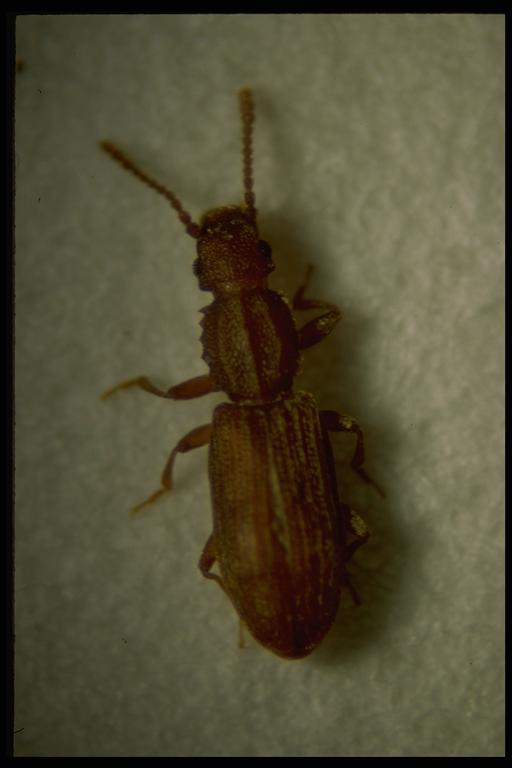
Sawtoothed grain beetle, Oryzaephilus surinamensis Linnaeus (Coleoptera: Cucujidae). Photo by Drees.
Common Name: Grain beetle
Scientific Name: Oryzaephilus surinamensis Linnaeus
Order: Coleoptera
Description: The adult beetle is a small (1/10 inch long), very flattened and brown with the segment just behind the head (pronotum) having characteristic “sawtoothed” outer margins, bearing six “teeth” on each side.
A closely related species, the merchant grain beetle, Oryzaephilus mercator (Fauvel), is very similar to the sawtoothed grain beetle but differs in the dimensions of the head capsule (i.e., the temple region just behind the eyes is shorter, less than the vertical diameter of the eye for the merchant grain beetle, being longer for the sawtoothed grain beetle).
Life Cycle: Fertilized females lay numerous shiny white eggs, singly or in clusters, in foodstuff and packaging. Larvae hatch from eggs in 3 to 17 days depending on temperature. Yellowish-white, deeply segmented larvae develop through several (two to four) stages (instars) while growing to about 1/8 inch long. Pupation often occurs in cells made of food particles cemented together, usually onto a solid object. Development from egg to egg occurs in 27 to 375 days. Four to six generations can occur annually.
Habitat and Food Source(s): Mouthparts are for chewing. Adults find their way into stored grains, flour, sugar, nuts and other dry material of plant origin through cracks and crevices of imperfectly sealed containers. They are incapable of attacking sound grain kernels and often occur in food previously infested by other stored product pests. This pest may be found infesting dry goods, crawling around kitchen surfaces and occasionally underneath tree bark.
Pest Status: Infests stored dry goods in the pantry; adults leave infested food sources can occur in the kitchen or other food storage areas and be a nuisance; medically harmless.
For additional information, contact your local Texas A&M AgriLife Extension Service agent or search for other state Extension offices.
Literature: Ebeling 1978; Swan & Papp 1972.